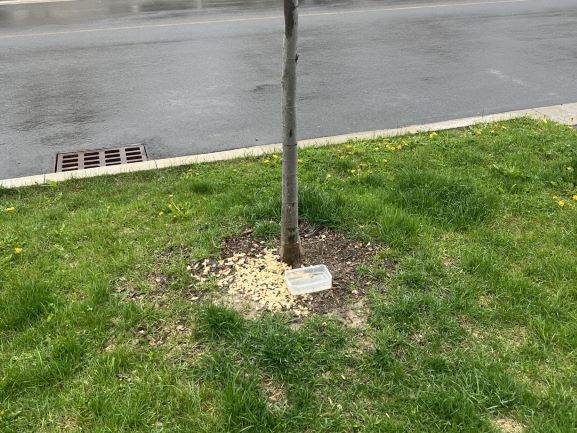BRAMPTON, ON – City of Brampton is addressing a recent influx in food being made available to wildlife to keep the community safe. The increased activity is most notable in the northwest part of the city, in the areas of Wanless Drive and Creditview Road. On two occasions, Brampton Animal Services officers have found food such as rice, cat food, chicken wings and noodles left in a residential area for coyotes. As a result, Brampton Animal Services has increased patrols in the area to enforce by-laws that prohibit the leaving of food or attractants for wildlife to prevent conflicts between wildlife and people or pets.

Food left out for wildlife on Queen Mary Drive in Brampton. Credit: City of Brampton
Feeding wildlife in Brampton is prohibited
Feeding wild animals can lead to dangerous situations for both animals and residents. Food left out in residential areas and along park trails, improper garbage disposal and spilled bird seeds from bird feeders are prohibited. Residents are required to keep garbage secured in garbage bins with the lids closed and to pick up any spilled bird seeds.
The City of Brampton strictly enforces by-laws prohibiting feeding wildlife. This includes squirrels, geese, ducks, pigeons, foxes and coyotes. Feeding wildlife purposely or inadvertently can result in a fine of $350. Over the first six months of the year, Animal Services officers have issued 25 penalty notices for feeding wildlife, resulting in $8,750 in fines, with 20 of those penalties being issued in the past three months.
Feeding of wildlife has been observed in almost every instance of negative interactions between residents and wildlife. When animals become dependent on humans for food, they may lose their natural fear and become familiar with humans, which can lead to conflicts.
Additionally, associating humans with food can cause animals to become assertive or even aggressive. Further, feeding wildlife can lead to the following concerns:
- animals may get sick because they are not eating the right food
- the spread of disease, as animals unnaturally gather at the same spot
- animals may start to demand food from people
Food left out for wildlife on Sugarhill Drive in Brampton. Credit: City of Brampton
How Brampton Animal Services helps keep the community safe
Since April 2024, Brampton's Wildlife Response team has been focused on minimizing the interactions between wildlife and residents by proactively conducting aversion conditioning on coyotes and foxes, reminding these animals to avoid areas where people are.
Over the past three months, the Wildlife Response team has conducted 168 patrols at 61 different locations in the city where frequent wildlife sightings occur and has conducted 21 instances of aversion conditioning, where officers use various techniques to reinforce a fear of people in foxes and coyotes.
How to care for wildlife in Brampton
Recognizing the desire to care for animals and residents’ compassion for wildlife in the community, instead of feeding them, residents who wish to help wildlife can:
- give wildlife their space and admire them from afar
- plant a pollinator garden to help support the ecosystem
- keep your yard neat and tidy
- volunteer with Animal Services to drive injured wildlife to rehabilitation centres
- call 311 to report food sources being left out for wildlife
Brampton’s Coyote Sighting Map
The City of Brampton’s interactive Coyote Sighting Map is a tool for the community to stay informed about when coyotes are in the area and prevent coyote encounters. Residents and visitors are encouraged to use this tool to stay safe when planning activities in nature and to report coyote sightings.
Steps to take if you encounter a coyote
- Stay calm: It might feel difficult, but if you are in the community and are approached by a coyote, remain calm.
- Do not run away: Running away from a coyote may encourage them to follow you.
- Make yourself loud and large: If a coyote continues to approach you, make gestures and use objects to startle the coyote into running away – do not chase or touch the animal.
- Call 9-1-1: Only in an emergency situation, otherwise call 3-1-1 to report an occurrence.
Contacting Brampton Animal Services
If in doubt, call Brampton Animal Services. Animal Services is always available to educate and inform, rescue and respond to all inquiries about wildlife in Brampton. They can be reached at 905.458.5800.
If you see a deceased or injured coyote, call Brampton Animal Services. Animal Control is on the road Monday through Friday from 7 am to 11 pm and on Saturday, Sunday and holidays from 8 am to 6:30 pm and is available after-hours for emergencies.
If a coyote is actively presenting an immediate threat to public safety by exhibiting aggressive behaviour such as lunging or biting, call 9-1-1. If the threat is no longer active or the public is not in immediate danger, call 3-1-1 to report an occurrence. If you observe a coyote that is not behaving aggressively, please report your sighting using the online interactive map.
Visit Brampton.ca/animalservices for more information and resources.
Quote
“Feeding wildlife creates dangerous situations, as it encourages animals such as coyotes to lose their natural fear of humans, potentially leading to aggressive behaviour. This issue is even more critical during this time as it is coyote pupping season, and coyotes and their young are out more frequently searching for food. We urge residents to follow our guidelines and adhere to the by-laws to do their part in maintaining a safe and harmonious coexistence with local wildlife. Our team is always available to help so do not hesitate to reach out. We are committed to working together to ensure our community remains a safe and thriving environment for both people and animals.”- Mike Mulick, Manager, Animal Service, City of Brampton
Media Contact
-30-
Media Contact
City of Brampton Media Relations
MediaRelations@Brampton.ca
